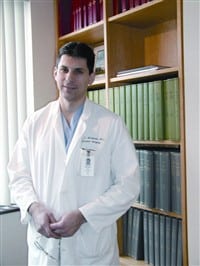The Light Fantastic Photodynamic Therapy Has A Bright Future In Cancer Treatment
A patient of Dr. Keith Mortman called him recently to relay an interesting bit of news.
“Doc,” he said, “I just ate a Philly Cheese steak.”
Taken out of context, the phone call might seem odd. But with the understanding that the patient had undergone photodynamic therapy (PDT) to treat esophageal cancer, and had just eaten his first few bites of solid food in months, the news served as validation that the little-known procedure is gaining acceptance in the medical community and breaking ground in cancer treatment and patient care.
Mortman, a thoracic surgeon and assistant professor of cardiothoracic surgery at Tufts University School of Medicine, joined Baystate Thoracic Surgery Associates eight months ago, and is now offering PDT to Western Mass. patients. He told The Healthcare News that the procedure essentially uses light to destroy cancerous and pre-cancerous cells and remove obstructions caused by tumors, and the innovative technology is the latest cancer treatment designed to kill harmful tissues but spare the healthy, surrounding area.
Traditional laser therapy is already used to treat several types of cancer because of its ability to precisely remove cancerous lesions, and targeted radiation therapy such as IMRT (Intensity Modulated Radiation Therapy) is also performed more frequently across the country, for instance. The newer treatment methods are less taxing on a patient’s body, and are increasingly effective in the treatment, relief, and even removal of cancerous cells.
PDT is also minimally invasive; first, a patient is injected with a photosensitizing drug, which is absorbed by all of the body’s cells. Cancer cells, however, retain the drug longer than healthy cells, and 24 to 72 hours after the injection, when the drug has left normal cells, the treatment area is exposed to light through an endoscopic procedure.
Mortman explained that the photosensitizer retained in the cancer cells and the laser light work together to create a reaction, producing oxygen that destroys the unhealthy cells but does not affect surrounding tissue. In addition, PDT will often damage blood vessels leading to tumors, causing them to shrink, and sometimes gives a patient’s immune system a boost, which in turn helps attack cancerous cells.
On the Beam
The procedure is primarily used for the esophagus and lungs, but its effectiveness in treating other cancers is being studied, including those of the brain, skin, prostate, and cervix. It is unique, Mortman said, not only because it is a much quicker and less damaging alternative to radiation and chemotherapy, but also because it can be used to treat early-stage conditions, such as Barrett’s Esophagus, a pre-cancerous disorder, as well as patients with advanced cancers that are not candidates for other surgeries.
Although it may not eradicate the disease in those cases, Mortman said it is an excellent way to palliate those patients, by removing blockages that prevent them from breathing normally, engaging in normal activity.
There are side effects, the most prevalent being a sensitivity to light for about a month that requires patients to avoid direct sunlight and wear long sleeves, gloves, dark glasses, and wide-brimmed hats to protect their skin (Mortman said the company that manufactures Photofrin, the photosensitizing drug used in PDT, even provides the glasses, hats, and gloves patients require). But he said these side-effects can be less disruptive to everyday life than others associated with surgery, radiation, or chemotherapy, such as shortness of breath, nausea, fatigue, and hair loss.
“We also see a much better response from patients with PDT, especially in terms of symptoms after the procedure,” he said. “One of the biggest improvements we see is a better ability to swallow, and that’s a big factor in the quality of a patient’s life.”
Mortman has become a strong proponent of PDT. He said it is effective for a large number of patients with esophageal and lung cancers, and has proven to be less disruptive to a patient’s life and more effective than some other treatments, including laser treatments. Generally, two courses of PDT treatment are required to successfully treat an affected area, and excluding the photosensitizer injection and the time it takes to exit healthy cells, the entire procedure only takes about eight minutes.
Currently, Mortman educates other doctors and the public on PDT, and is attempting to broaden awareness of the availability of the procedure locally, gradually expanding his reach to Pittsfield, Brattleboro, Worcester, and Albany. He said PDT was developed six years ago, but has only begun to gain more notoriety in the past two years.
“Familiarity of PDT is growing, but it’s still limited,” he said. “Much of the public definitely doesn’t know it exists, and many doctors aren’t familiar with it yet.”
Mortman said PDT is a new specialty of thoracic surgery, but uses endoscopic technology, a practice already widely used in many areas of medicine, and not so specialized that it can’t be effectively integrated into the surgical repertoires of many hospitals of varying sizes.
“PDT also doesn’t preclude other treatments later on,” he said.
Lighting the Way
The reduced treatment time, less damaging side-effects, and added options that PDT offers patients all add to the procedure’s growing popularity, said Mortman, who noted that there many clinical studies underway involving PDT that could benefit patients with a number of different types of cancerous and pre-cancerous conditions in the future.
Mortman said those benefits could be the full removal of a cancerous tumor or an easier way for cancer patients to maintain their health for longer periods of time. Or, it could mean just one patient can sit down for a family dinner, and enjoy the entrée as well as the company.



Comments are closed.